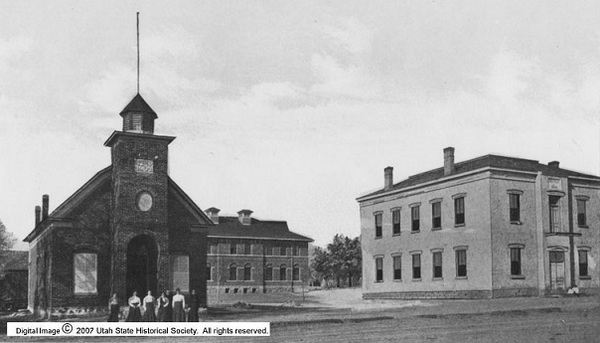Dublin Core
Title
Description
The relationship between the desires of the spiritual community of Utah and the non-religious needs of the West characterize the growing Mormon frontier.
In 1856, a small party of fifteen Mormon families left Parowan in Iron County intent on carving out a new settlement on the banks of the Beaver River. Led by Simeon Howd, who came to the Great Basin with Brigham Young in 1847, the emigrant company was able to make the thirty-mile trip north in two days, meaning they only had to spend a single night on the frozen February ground. According to Wilson Nowers, one of the Beaver emigrants, the company built a bonfire of sagebrush to thaw the hard earth, then buried their food to protect it from freezing before spreading their blankets over the newly warmed soil. When morning came, they dug up their cached provisions, packed up their wagons, and headed into Beaver Valley.
Upon reaching the valley, the emigrants immediately began the process of building a new community, clearing new fields and throwing up makeshift cabins to protect themselves from the winter chill. This was quickly followed by a move to help provide for their spiritual needs. Just two days after reaching the banks of the Beaver, on February 8, the colonizers established a branch of the LDS Church, with Simeon Howd as president. Ironically, that same day, the new branch president also finished building a “house of entertainment” or tavern at the point where the road between Salt Lake and Parowan crossed Beaver Creek. The tavern, read an article in the Deseret News, would be a “great accommodation to the traveling public.”
How ought we to interpret this temporal mixing of the sacred and profane on the Mormon frontier? Well, perhaps it reinforces the reality that while the spiritual community the LDS people worked to build in the Far West was undoubtedly unique, the Mormons definitely felt a pressing obligation to provide for non-religious needs. As in other parts of the nineteenth-century West, both facets of frontier settlement—the sacred and the profane—grew up together in Utah.
Creator
Source
Image: West Ward, Beaver, Utah. Image shows the Relief Society Hall, Belknap School, and West Ward Beaver Meeting house. Courtesy of Utah State Historical Society.
_______________
See Deseret News, March 5, 1856; Martha Sonntag Bradley, A History of Beaver County (Salt Lake City: Utah State Historical Society and Beaver County Commission, 1999), 51-52, 80; Will Bagley, ed., The Pioneer Camp of the Saints: The 1846 and 1847 Mormon Trail Journals of Thomas Bullock (Logan: Utah State University Press, 2001); and Ronald O. Barney, ed., The Mormon Vanguard Brigade of 1847: Norton Jacob’s Record (Logan: Utah State University Press, 2005),

